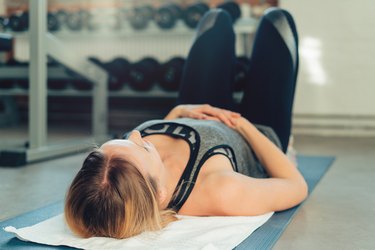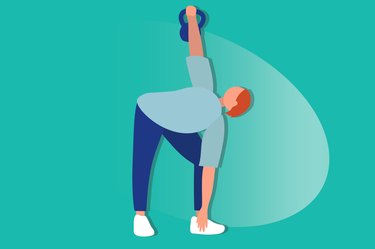

The bent knee fallout exercise involves only the smallest of motions, but is has big payoffs. This lying body-weight exercise can help keep your lower back healthy, improve your pelvic stability and even increase your hip mobility. As a bonus, you can add foam rollers and resistance bands to make this move even more challenging.
- What is the bent knee fall out exercise? Also called side-to-side knee drops and abbreviated as the BKFO, it's an exercise in which you lie on your back (the supine position) with your knees bent and feet flat on the floor. Then, you slowly let your legs fall to the side one at a time as you use your core muscles to prevent your pelvis and trunk from moving or twisting. It is used both as a core exercise and as a test to monitor lumbar and pelvic stability as well as hip and groin injuries.
- What muscles does the bent knee fall out work? "This is a great exercise for bringing awareness to the deeper core muscles — like the transverse abdominis and obliques — as you control the position of the low back and pelvis with the added challenge of leg position changes," says Leada Malek, PT, DPT, a physical therapist and board-certified sports specialist. In addition, this exercise stretches the hips and inner thighs.
- Who can do this exercise? This exercise is great for those who want to strengthen their deep core muscles and improve pelvic stability, especially in people who have back pain or are postpartum. Because of the gentle nature of this move, there are very few cases in which you should not do it. "If you have had any hip surgeries that have hip range of motion precautions set in place, then you would want to run this by your physician or physical therapist first," says Malek. If you have pain during this move, stop and talk to your doctor.
Video of the Day
Ready to get started? Below, Grayson Wickham PT, DPT, CSCS, founder of Movement Vault, shares a full guide on how to do bent knee fall outs for the maximum benefits.
How to Do Bent Knee Fall Out Exercise With Proper Form
Bent Knee Fall Out
- Lie on your back with knees up, hip-width apart and feet flat on the floor.
- Place your palms down on the floor.
- Do a deep diaphragmatic breath, letting the air fill your stomach as you inhale.
- As you exhale, slightly tuck your pelvis under so your lower back is flat against the floor. Think about pushing your belly button down to the floor to activate your deep core muscles.
- Slowly let your left leg fall out to the side. Don’t let your hips turn or your back rotate. Keep your core contracted throughout the move.
- Only let your leg fall out to the point where you can keep your hips and pelvis stable, but no more than 45 degrees to the side.
- Bring it back to the starting position.
- Do all reps on the left side, then switch to the right leg.
Once you can do 20 reps on each leg keeping your pelvis and hips stable, perform this exercise with both legs falling out at the same time.
Watch the Full Tutorial
4 Benefits of the Bent Knee Fall Out Exercise
1. It Strengthens Your Deep Abdominal Muscles
The deep abdominal muscles can be difficult to isolate and strengthen, but it's important to work them because they literally support your entire body. A strong core has endless benefits. To name a few: It supports your low back, improves posture and stabilizes your body during almost every lift, cardio activity (running, walking, biking) and everyday movement. Your core really does it all.
The supine bent knee fall out exercise helps to isolate and target the transverse abdominis in particular — the deepest of all the abdominal muscles, which stabilizes the spine and pelvis — and is a good first step for improving overall core stability and strength.
2. It Improves Pelvic Floor Stability
Side-to side-knee drops strengthen and improve control of your deep core muscles, which not only include your abdominal muscles, but also the pelvic floor muscles that support your bladder, bowel and, if you have one, uterus, according to Harvard Health.
While this exercise is great for everyone's pelvic floor, it's worth calling out its benefits for people after pregnancy. A strong pelvic floor can help prevent and manage postpartum difficulties such as incontinence and pelvic organ prolapse. "After pregnancy, it's important to relearn how to target your core and breath and coordinate these things for optimal control," says Malek.
3. It Can Help Reduce Low Back Pain
The transverse abdominis is one of the major muscles that helps to provide stability to your lower back — and strengthening it can help improve low back strain and pain, according to December 2019 research in the Journal of Exercise Rehabilitation.
Another way the move helps support your back is through the combo of diaphragmatic breathing and core strengthening work.
"It's a really great step in learning how to coordinate your breath with core control," Malek says. "While lacking this may not always result in back pain, it can play a role in core efficiency and stability of the trunk and pelvis."
4. It Tests Core Strength and Hip Mobility
This drill is not only an exercise, but it is also used as a diagnostic tool when looking at core strength and even hip mobility. "It tests the ability to prevent rotation of the lumbar spine during abduction/lateral rotation of the hip," explains Malek.
You can use the bent knee fall out test as a self-test by monitoring how far your leg will fall before you lose control of your core. As your core strength improves, you should be able to let your leg fall out further without losing control. You may even notice that you have more control on one side than the other.
4 Form Tips for Better Results
Even though BKFO's looks easy at first glance, you must do them correctly to get the maximum benefits. And that can be challenging. The following tips will ensure you are using your core, not momentum or gravity, to help strengthen your abdominals and pelvic floor.
1. Resist the Urge to Twist
When doing the single-leg knee drops, the weight of your leg falling out to the side will make your torso want to twist to that side. Use your core muscles to prevent that from happening. This is when that deep abdominal contraction takes place.
Think about keeping the knee of the stationary leg pointed straight up and your pelvic bones pointed up to the ceiling. When doing a double-leg bent knee fall out, your torso may want to twist towards your weaker side. Again, use your core to resist.
2. Use Your Hands to Check Your Pelvis
"Place your hands on your hip bones to help with some awareness," says Malek. "While maintaining a stable pelvis, slowly let one knee fall out within your available range of motion without letting your pelvis or low back rotate. Return to the starting position and repeat."
If you feel your hands move, then you aren't maintaining control of your core. Make sure your core is contracted, bring your leg back in and try again.
3. Keep Your Low Back Pinned to the Floor
Your core should be tight throughout the entire movement. "Slightly tilt the pelvis back by engaging your abdominals," says Malek. Another way to think of it is to imagine your low back flattening against the floor while you tighten your abdominals.
Your core should be working throughout the entire movement. You know your core has checked out when your trunk starts to rotate or your pelvis starts to twist.
4. Stop When You Can’t Maintain Control
As you let one leg fall out to the side, only go as far as you can while maintaining control. Move slow and controlled to really let your core work. If you feel your trunk or pelvis rotate, pull your leg back in and on the next rep, stop before that happens. As your strength improves, you will be able to let your leg fall out further to the side while maintaining control.
3 Bent Knee Fall Out Variations for an Added Challenge
Once you have mastered the single-leg and the double-knee fall outs, it is time to mix things up to further challenge your core. Here, Wickham shares three awesome progressions.
Move 1: Foam-Roller BKFO
To further challenge your core, instead of keeping your hands on the ground, raise your hands straight overhead while performing the exercise on a foam roller. Your core will have to work harder to keep your pelvis stable, Wickham says.
- Lie on a medium density foam roller that is long enough to support you from your head down to the bottom of your pelvis.
- Bend your knees and place your feet flat on the ground.
- Place your palms down on the ground for stability.
- Tighten your core, pressing your back into the foam roller.
- Slowly let your left leg fall out to the side, maintaining your core contraction.
- Don't let your pelvis or truck twist. Keep your hips pointed straight up.
- Repeat 10 times on the left side. Repeat on the right side.
- Once you can do 20 reps each side while maintaining control (without twisting), let both legs fall out at the same time.
Move 2: Mini-Band BKFO
By putting a mini bound around your knees, you add resistance to both your glutes and core.
When you're ready to make this move more difficult, use a heavier band. Wickham says you can also put your hands straight up in the air while performing this movement, instead of using them to help stabilize yourself.
- Place a resistance band just above your knees. Start with a light band and progress to a heavy band.
- Lie on your back with your feet flat and legs hip-width apart.
- Press your low back into the ground to activate your core.
- Place your palms flat on the ground.
- Push against the band, moving your left leg out to the side.
- Move slow and controlled. Keep your core tight throughout the movement.
- Repeat 10-20 times each side. Once you have mastered the single-leg version, progress to double-knee one.
Move 3: Stability-Ball BKFO
The bent knee fall out on a stability ball is challenging. Wickham recommends doing this exercise after you have mastered the other variations.
- Lie on an exercise ball with your back supported and your knees bent with your feet flat on the floor.
- Place your hands behind your head and keep your head in line with your torso. You should be in a straight line.
- Press your low back into the ball to activate your core.
- Slowly let one leg fall out to the side, maintaining your core activation and keeping your trunk stable.
- Repeat 10-20 reps on one side and switch to the other side.
- Once you can do 20 on one leg with good control, perform the exercise with both legs falling out.
More Exercises for Core Strength and Joint Mobility
- BMC Musculoskeletal Disorders: "Inter- and Intra-Observer Reliability of Clinical Movement-Control Tests for Marines"
- Physical Therapy in Sport: "The Inter-Tester Reliability of the Squeeze and Bent-Knee-Fall-out Tests in Elite Academy Football Players"
- Journal of Exercise Rehabilitation: "Comparison of the Recruitment of Transverse Abdominis Through Drawing-in and Bracing in Different Core Stability Training Positions"
- Harvard Health Publishing: "Shore Up Your Core"
- Kaiser Permanente: "Postpartum Fitness Getting Back in Shape After Your Pregnancy"


